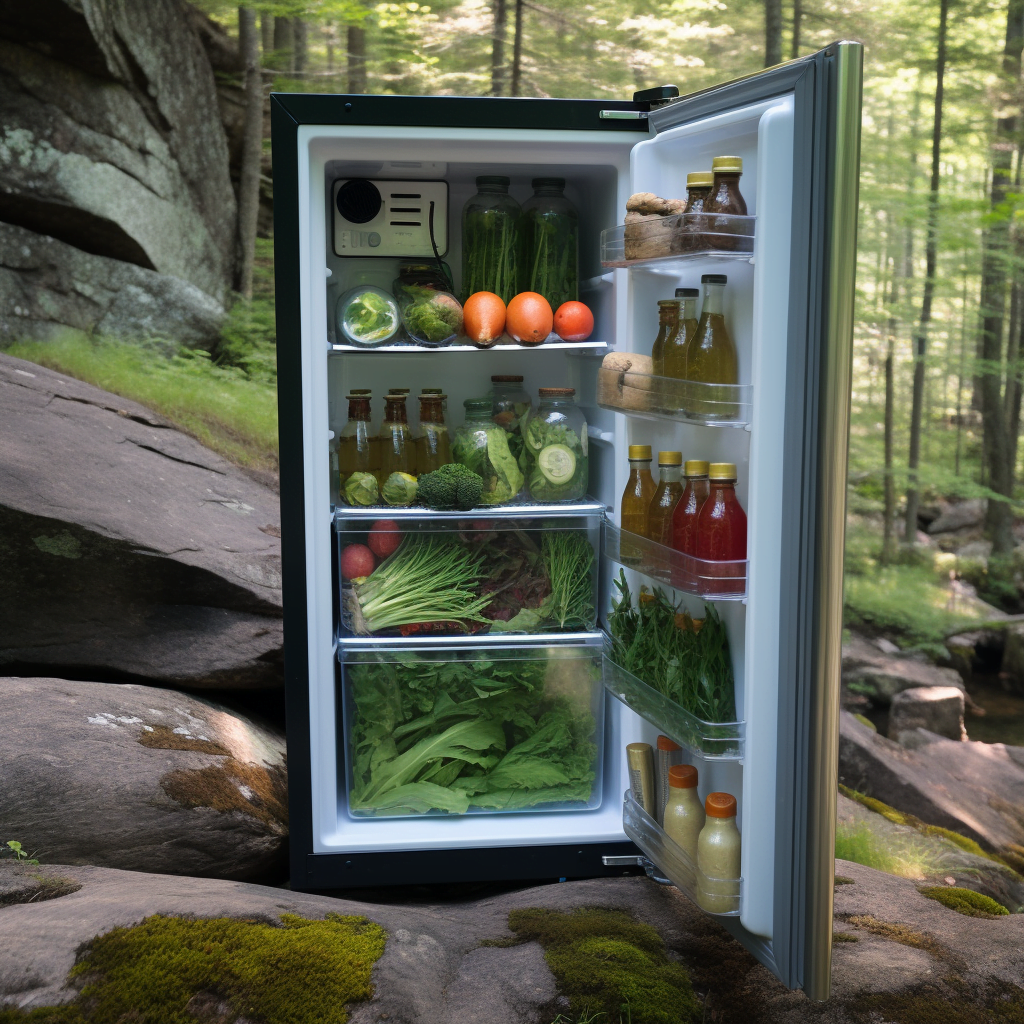Are you tired of relying on electricity to keep your food cold? Do you want to learn how to create an off-grid refrigerator using natural methods? Well, you’re in luck! In this article, I’m going to explain everything you need to know about off-grid living and how to make a natural refrigerator that doesn’t require any electricity.
Living off the grid means being self-sufficient and not relying on public utilities like electricity. It’s a lifestyle that allows you to be more sustainable and reduce your carbon footprint. One of the challenges of off-grid living is keeping your food fresh without the use of a traditional refrigerator. But fear not, because there are natural methods you can use to create your very own off-grid refrigerator.
So how can you make a natural refrigerator? One method is by using evaporation. You can create a simple DIY cooler by burying a container underground and covering it with a wet cloth. As the water evaporates, it will cool the air inside the container, keeping your food fresh. Another method is by using a zeer pot, which is essentially an earthenware pot within a larger clay pot. By keeping the sand between the two pots wet, evaporation will occur and cool the inner pot.
These are just a few examples of how you can create an off-grid refrigerator using natural methods. In the full article, we’ll dive into more detail and explain step-by-step instructions on how to make these coolers. So, if you’re interested in learning more about off-grid living and becoming more self-sufficient, keep reading!
Off Grid Living
Introduction to Off Grid Living
Off-grid living is a lifestyle that involves relying on self-sufficient systems rather than traditional utilities such as electricity and water supply. People who choose to live off the grid often strive to reduce their environmental impact and become more self-reliant. One crucial aspect of off-grid living is finding alternative solutions for everyday needs, including refrigeration.
Advantages and Challenges of Off Grid Living
Living off the grid offers numerous advantages. It allows individuals to reduce their dependence on non-renewable resources, lower their utility bills, and have greater control over their energy consumption. Additionally, off-grid living encourages a closer connection to nature and promotes sustainable living practices.
However, there are also challenges that come with off-grid living. One of the main challenges is obtaining a reliable source of energy, especially for refrigeration. Traditional refrigerators require constant electricity, which may not be readily available in off-grid locations. This is where natural refrigeration methods come into play.
Importance of Sustainable Solutions
In the pursuit of off-grid living, it is crucial to prioritize sustainable solutions. Sustainable solutions not only reduce environmental impact but also help maintain a more self-sufficient lifestyle. By utilizing natural refrigeration methods, individuals can significantly reduce their energy consumption and rely on renewable resources.
Understanding Natural Refrigeration
Concept of Natural Refrigeration
Natural refrigeration utilizes principles of evaporation, insulation, and passive cooling to maintain low temperatures without the need for electricity. It harnesses the natural properties of materials and the surrounding environment to create a cool storage environment.
How it Differs from Conventional Refrigeration
Conventional refrigeration relies on electricity to compress refrigerants and maintain low temperatures. On the other hand, natural refrigeration methods leverage natural processes such as evaporation to create cool environments.
Benefits of Natural Refrigeration
There are several benefits to using natural refrigeration methods. Firstly, they do not require electricity, therefore reducing energy consumption and dependency on non-renewable resources. Moreover, natural refrigeration methods can be easily implemented using locally available materials, making them cost-effective and accessible to everyone. Additionally, natural refrigeration is environmentally friendly, as it does not emit greenhouse gases or use harmful refrigerants.

Exploring Off-Grid Refrigeration Methods
In the quest for off-grid refrigeration, various natural methods can be utilized. Let’s explore some of the most popular ones:
Evaporative Cooling
Evaporative cooling is a simple and effective method that utilizes the principle of evaporation to lower temperatures. It involves using a porous material that absorbs water and dissipates heat through evaporation. As the water evaporates, it cools the surrounding environment.
Zeer Pot Fridge
The Zeer pot fridge is a traditional method that has been used for centuries in arid regions. It consists of two clay pots, one placed within the other, with a layer of sand in between. The sand is kept moist, and as it evaporates, it cools the inner pot, creating a refrigeration effect.
Sand Pot Fridge
Similar to the Zeer pot fridge, the sand pot fridge utilizes the cooling properties of sand. It involves burying a clay pot partially in the ground and surrounding it with moist sand. The evaporating moisture cools the pot and helps to preserve perishable items.
Coolgardie Safe
The Coolgardie safe is a simple yet effective refrigeration method commonly used in hot climates. It consists of a wooden frame covered with hessian or burlap, which is kept damp. As air passes through the wet cloth, it cools down and lowers the temperature inside the safe, providing a cool storage space.
Pot-in-Pot Refrigerator
The pot-in-pot refrigerator is a clever technique that utilizes clay pots to create a cool storage environment. It involves placing one clay pot inside another and filling the gap between them with wet sand. As the water evaporates, it cools the inner pot, keeping the contents cool.
Evaporative Cooling
Principle Behind Evaporative Cooling
Evaporative cooling works on the principle that as water evaporates, it absorbs heat from the surrounding environment, thereby lowering the temperature. This process is highly efficient and can significantly reduce the temperature in an enclosed space.
Materials Required for an Evaporative Cooler
To build an evaporative cooler, you will need the following materials:
- A large container or basin
- A small, portable fan
- A pump or wick to distribute water
- A porous material such as hessian or straw
Step-by-Step Guide to Building an Evaporative Cooler
- Place the small portable fan near the large container or basin.
- Fill the basin with water, ensuring it covers the bottom surface.
- Soak the porous material such as hessian or straw in the water.
- Hang or place the soaked material over the basin, allowing the excess water to drip back into the basin.
- Turn on the fan, directing it towards the soaked material.
- As the fan blows air over the wet material, it will create evaporative cooling and lower the temperature in the surrounding area.
Zeer Pot Fridge
Understanding the Zeer Pot Fridge
The Zeer pot fridge is a natural refrigeration method that has been used for centuries in dry regions. It involves utilizing the cooling effect of evaporation to preserve food without the need for electricity.
Materials Needed for Building a Zeer Pot Fridge
To construct a Zeer pot fridge, gather the following materials:
- Two clay pots of different sizes
- Sand
- A cloth or burlap
- Water
Constructing a Zeer Pot Fridge in Easy Steps
- Place the larger clay pot on a flat surface.
- Fill the bottom of the pot about one-third full with sand.
- Position the smaller clay pot in the center of the larger pot, ensuring there is space between them.
- Fill the gap between the pots with sand, making sure to pack it tightly.
- Wet the cloth or burlap and cover the smaller pot with it, allowing the excess to drape over the sides.
- Pour water over the sand to saturate it.
- Place the food or items that need to be cooled in the smaller pot.
- Cover the entire setup with a damp cloth to enhance evaporative cooling.
Sand Pot Fridge
What is a Sand Pot Fridge
A sand pot fridge is a simple and effective natural refrigeration method that utilizes the cooling properties of sand. It is suitable for arid regions where access to electricity is limited.
Materials Required for Building a Sand Pot Fridge
To build a sand pot fridge, you will need the following materials:
- A large clay pot with a lid
- Sand
- Water
Step-by-Step Instructions to Build a Sand Pot Fridge
- Bury the clay pot partially in the ground, leaving the lid exposed.
- Fill the bottom of the pot with a layer of sand.
- Place the food or items that need to be cooled on top of the sand.
- Cover the items with another layer of sand, ensuring they are completely surrounded.
- Pour water over the sand to make it moist.
- Place the lid on top of the pot to cover the sand.
Coolgardie Safe
Introduction to Coolgardie Safe
The Coolgardie safe is an Australian refrigeration method commonly used during the late 19th and early 20th centuries. It relies on the principles of evaporative cooling to keep food items cool in hot climates.
Materials Needed for Constructing a Coolgardie Safe
To build a Coolgardie safe, gather the following materials:
- A wooden frame
- Hessian or burlap cloth
- Nails or screws
- Water
Building a Coolgardie Safe – A Detailed Guide
- Construct a wooden frame in the desired size and shape.
- Attach hessian or burlap cloth to the frame, ensuring the entire frame is covered.
- Wet the cloth thoroughly, allowing it to soak up the water.
- Hang the dampened cloth around the food storage area, making sure it is in contact with the frame.
- Ensure proper ventilation by leaving gaps or openings in the safe to allow air circulation.
- The evaporative cooling effect will keep the food items inside the safe cool.
Pot-in-Pot Refrigerator
Understanding the Concept of a Pot-in-Pot Refrigerator
The pot-in-pot refrigerator is an ingenious natural refrigeration method that utilizes two clay pots to create a cool storage environment. It is commonly used in regions with hot climates and limited access to electricity.
Materials Required for Building a Pot-in-Pot Refrigerator
To construct a pot-in-pot refrigerator, gather the following materials:
- Two clay pots of different sizes
- Sand
- Water
Step-by-Step Instructions to Construct a Pot-in-Pot Refrigerator
- Place the larger clay pot on a flat surface.
- Fill the bottom of the pot with a layer of sand.
- Position the smaller clay pot in the center of the larger pot.
- Fill the gap between the pots with sand, ensuring it is packed tightly.
- Pour water over the sand to saturate it.
- Cover the entire setup with a damp cloth or burlap.
- Place the food or items that require cooling inside the smaller pot.
- Cover the smaller pot with a lid or cloth to seal it.

Choosing the Right Method
Factors to Consider When Selecting a Natural Refrigeration Method
When choosing a natural refrigeration method, consider the following factors:
- Climate: Different methods may work better in specific climates. For example, evaporative cooling is most effective in dry and hot regions, while pot-in-pot refrigerators work well in areas with moderate temperatures.
- Availability of Materials: Choose a method that utilizes locally available materials to ensure accessibility and cost-effectiveness.
- Storage Requirements: Consider the size and capacity of the refrigerator needed for your specific storage requirements.
Suitability of Each Method for Different Climates
- Evaporative Cooling: Ideal for hot and arid climates where moisture is readily available.
- Zeer Pot Fridge: Effective in regions with hot and dry climates.
- Sand Pot Fridge: Suitable for hot climates where access to electricity is limited.
- Coolgardie Safe: Suitable for hot and dry climates where airflow is limited.
- Pot-in-Pot Refrigerator: Works well in regions with moderate temperatures and limited access to electricity.
Comparing the Efficiency and Effectiveness of Each Method
Each natural refrigeration method has its advantages and limitations. The efficiency and effectiveness of each method depend on factors such as climate, availability of materials, and specific cooling requirements. It is recommended to experiment with different methods and adjust them according to individual needs and circumstances.
Conclusion
In conclusion, off-grid living offers numerous advantages in terms of environmental sustainability and self-sufficiency. When it comes to refrigeration, natural methods present practical and energy-efficient solutions. Evaporative cooling, Zeer pot fridges, sand pot fridges, Coolgardie safes, and pot-in-pot refrigerators are all viable options, each with its unique advantages. By implementing these natural refrigeration methods, you can reduce your energy consumption, decrease your reliance on electricity, and embrace a more sustainable lifestyle. It’s time to explore and implement these natural refrigeration methods and enjoy the benefits of off-grid living.




